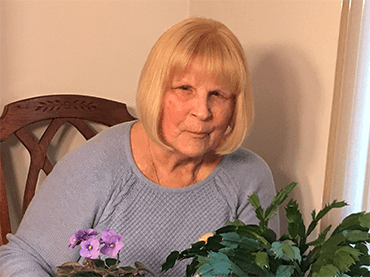Barbara, 73, had just arrived at her grandson’s basketball game in November 2022 when she tripped and fell, badly cutting her leg. She ended up with 25 stitches and a follow-up MRI.
“Turns out that was my lucky day,” says Barbara, a Verona, Pa., resident. “If I hadn’t fallen and had that MRI, I probably would have wound up in a wheelchair.”
The Challenge: A Massive Growth
The MRI showed a schwannoma tumor with a volume about the size of an avocado pressing on Barbara’s spinal cord. A spinal Schwannoma is a tumor that grows from abnormally divided Schwann cells, which cover the nerve cells in the spine.
A Schwannoma is a rare disease affecting fewer than 200,000 people in the United States each year. It rarely occurs in children. Like Barbara’s, most Schwannomas are benign. Some people have symptoms while others don’t. They can include back pain, leg muscle weakness, balance issues, dizziness, and numbness. Schwannomas are usually slow growing, and people can go years without knowing they have one.
Although she didn’t experience any obvious symptoms, Barbara’s fall probably was an indicator of the disease, which can lead to loss of muscle control and nerve damage. The dumbbell-shaped tumor was compressing her spinal cord and had invaded her chest cavity where it was pressing on her aorta and left lung.
“It was a massive growth,” says Barbara. “I knew it had to be removed.”
The Path to UPMC
Barbara immediately called her brother, a retired hospital CEO in St. Louis. He suggested she see Kojo Hamilton, MD, a neurosurgeon at UPMC Presbyterian and director of UPMC Neurosurgical Spine Services. He specializes in complex spine surgery.
Dr. Hamilton explained that without surgery she risked becoming paralyzed. The growth also posed a significant threat to her cardiovascular system. She would need surgery to remove the tumor and stabilize her spine.
“As soon as I met Dr. Hamilton, I knew I was in the right place,” says Barbara. “It was scary to hear this diagnosis, but I had faith in him as my surgeon. I knew I was in good hands.”
The Solution
Barbara was admitted to UPMC Presbyterian on April 4, 2023, for extensive testing and presurgery planning, including a lengthy MRI.
Two days later, she underwent surgery with a team of surgeons, including Dr. Hamilton and Nitin Agarwal, MD, a UPMC Presbyterian neurosurgeon and spine specialist. Dr. Agarwal is director of the Department of Neurological Surgery’s minimally invasive spine and robotic surgery program.
The complex two-stage procedure began with robotic video-assisted thoracic surgery (VATS) to release and immobilize the tumor from her chest and spinal cavity. The second stage of the surgery was a laminectomy in which a portion of the vertebrae (lamina) was removed to gain access to the tumor in the spinal canal. After removing the tumor, the surgeons performed a fusion procedure to stabilize Barbara’s spine with a rod.
The surgery lasted over seven hours. The goal was to remove as much of the tumor as possible to reduce the possibility of recurrence and relieve pressure on the nerve root. A biopsy later confirmed the tumor was benign.
The Results
“Within days, I was up and walking in my hospital room without a cane or walker,” says Barbara. She was discharged five days after her surgery.
Barbara went through six weeks of physical therapy. By the summer, she was back to tending her garden. Because she must be careful how she bends, she sits on the ground to plant flowers and pull weeds. She uses a chair to help her get down and back up.
“I was so lucky. I’m very grateful that I’m not paralyzed. And to be able to walk without a cane is just mind boggling,” she says. “I look forward to doing more gardening and traveling in 2024.”
Barbara, now 74, credits her team of surgeons for doing a great job.
“They knew what they were doing, and they were very thorough,” she says.
“I never had any doubt that everything would be OK. I put all my faith in Dr. Hamilton.”
















